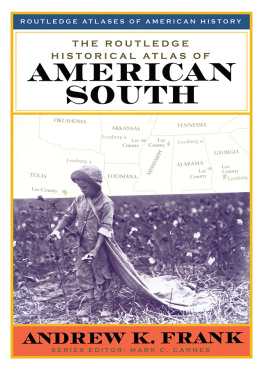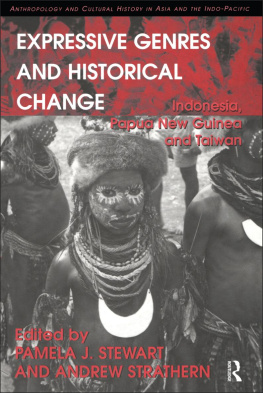THE ROUTLEDGE HISTORICAL ATLAS OF THE AMERICAN SOUTH
THE ROUTLEDGE HISTORICAL ATLAS OF THE AMERICAN SOUTH
ANDREWK.FRANK
MARKC.CARNES,SERIES EDITOR
Published in 1999 by
Routledge
711 Third Avenue
New York, NY 10017
Published in Great Britain in 1999 by
Routledge
2 Park Square, Milton Park
Abingdon, Oxon OX14 4RN
Routledge is an imprint of the Taylor & Francis Group, an informa business
Text copyright 1999 by Andrew K. Frank
Maps and design 1999 by Arcadia Editions Ltd
All rights reserved. No part of this book may be reprinted or reproduced or utilized in any form or by any electronic, mechanical, or other means, now known or hereafter invented, including photocopying and recording or in any information storage or retrieval system, without permission in writing from the publishers.
Routledge, Inc. respects international copyright laws. Any omissions or oversights in the acknowledgments section of this volume are purely unintentional.
Library of Congress Cataloging-in-Publication Data
Frank, Andrew, 1970
The Routledge historical atlas of the American South / Andrew
Frank.
p. cm. (Routledge atlases of American history)
Includes index.
ISBN 0-415-92135-X (cloth: alk. paper). ISBN 0-415-92141-4
(pbk: alk. paper)
1. Southern StatesHistoryCivil War, 18611865Maps.
2. Southern StatesHistory18651877Maps. 3. Southern States
Social conditions18651945Maps. 4. Southern StatesEconomic
conditionsMaps. I. Titles. II. Title: Historical atlas of the
American South. III. Series.
G1281.S5 F7 1999
912.75DC21 9925582
CIP
MAPS
When Routledge invited me to serve as general editor of this series, the first title I proposed became this volume. To note that the South warranted special consideration was no act of genius. The South has always been this nation's most distinctive region, and interest in regional history has grown rapidly within the past decade, much of it focused on the South. Scholars have devised specialized courses and academic programs on Southern history, and the subject has stimulated a host of scholarly monographs along with reference works ranging from encyclopedias and biographical collections to guidebooks on language and folkways.
My own awareness of this commonplace was hammered home while I was working on Mapping America's Past (1996), a historical atlas of the entire nation. A historical atlas conveys information visually, and I soon learned that the eye is attracted to contrast. What my eye was unavoidably drawn to, in so many national maps, was the South.
This came as little surprise in the maps on presidential politics: the political crisis of the antebellum era culminated in a Civil War whose regional dimension was explicit. The diffusion of cotton cultivation was a consequence of Eli Whitney's invention of the cotton gin in 1793, and of the growing demand for cotton among British and American textile manufacturers. But geography and climate conspired to ensure that the cotton kingdom would be a southern realm. Short-strand cotton flourished in the rich prairies of central Alabama and Mississippi, in the drier upland regions of the South, and especially along the alluvial deposits of the numerous rivers that flowed from the Appalachians into the Gulf of Mexico. Cotton cultivation-and the proliferation of slavery in the regions where it was cultivated-was the signal political fact of the antebellum South. During the century after the Civil War and Reconstruction, unresolved issues of race permeated Southern politics in ways that had no analogue in the rest of the nation.
But I saw that the differences between the South and elsewhere were pronounced in many topics far removed from issues of slavery and race. Southern voters were far more likely to favor imperialism in the 1890s and isolationism during the 1930s, to oppose woman's suffrage in the 1910s and the equal rights amendment for women in the 1970s. In demographic terms, the seventeenthcentury South was disproportionately male; and white women in the nineteenth-century South had far more children than white women elsewhere. During the early decades of the twentieth century, literacy rates in the South were lower, as were per capital expenditures on public education. Throughout the past three centuries, religious affiliation has been higher in the South than elsewhere. These and many other differences confirmed the distinctiveness of the South as a region, and its salience for further study.
Andrew K. Frank illuminates these and other singular aspects of Southern society and culture. But even as this volume provides justification for thinking about the South as a region unto itself, it also shows that the South in fact consists of many shifting social and cultural sub-regions. The South has been and still remains a changing kaleidoscope of peoples, economic and political systems, and cultures.
Much is made of this nation's diversity; the same is true, as Frank ably shows, of its most distinctive region.
Mark C. Carnes
Barnard College, Columbia University
Perhaps the adage applied to obscenity"I can't exactly define it, but I know it when I see it"-also applies to the American South. It seems that everyone recognizes the region's existence, but few can coherently define it. At times it has been a nation, a region within a nation, a relatively cohesive culture, and an area of cultural interaction. It has existed alongside, and sometimes in contrast to, New England, the North, the Union, the West, and even the United States. Parts of it were once Spanish, French, English, Native-American, and English territories. Over time, the American South has changed in meaning, geography, and culture. However, throughout its history the South has been, in the words of historian C. Vann Woodward, "American a long time before it was Southern in any self-conscious or distinctive way. It remains more American by far than anything else, and has all along."
The ambiguous and historical nature of the American South should not deter us from trying to define it. This volume, in large part, is an attempt to offer a historical definition. As the label "American South" implies, it is impossible to define the South without attaching it to a particular placethe southeastern corner of the United States. Yet geography defines as well as divides the region. Several subregions and distinct terrains exist within the American South. There is an Upper South, Lower South, Chesapeake, old Southwest, and Gulf Coast. The South contains a Piedmont, Tidewater, Appalachia, Ozarks, Coastal Plains, Alluvial Lowlands, Everglades Swamp, and Mississippi Delta. A myriad of rivers cross the region, including the Potomac, Rappahannock, Cumberland, Chattahoochee, Appalachicola, and of course Mississippi. Yet within this topographic diversity exists a shared understanding that the South stretches from somewhere just north of the Chesapeake Bay to the southernmost point of the Florida Keys. It extends west into Arkansas, Texas, and perhaps to Missouri and Oklahoma.
The American South, however, has not been borne of simply geographic space. The region has also been a historical entity. In large part, the American South owes its creation to the seventeenth-century decision of Virginian tobacco planters to import African-American slaves. The development of chattel slavery has shaped the history of the American South, as have the tobacco, rice and cotton plantations on which slaves labored. After the American Revolution, as Northern states gradually abandoned the use of unfree labor, the connection between slavery and geography became more pronounced. The nation divided into "free states" and "slave states," with the latter being used in lieu of the term "Southern states." Slavery did not completely define the South, but the South cannot be defined without it.















